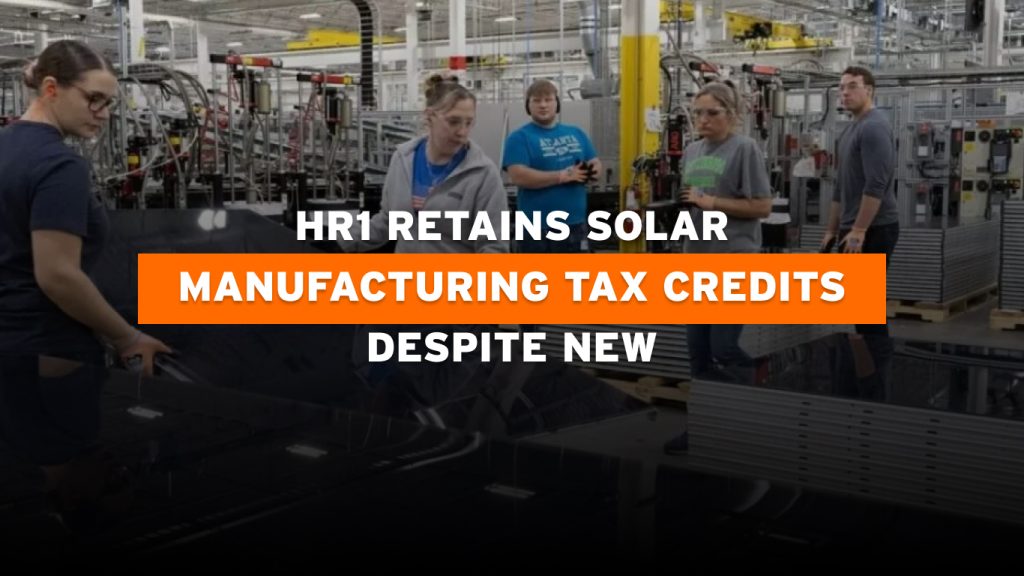The U.S. House passed HR1, a signature component of the broader reconciliation package. While the bill preserved the 45X advanced manufacturing tax credit for solar and storage production, it introduced fresh challenges that may impact manufacturers and developers, according to Solar Power World .
What HR1 Maintains—and What It Changes
HR1 thankfully retained the 45X credit that incentivizes domestic production of solar panels, inverters, energy storage systems, tracking systems, and more. Solar Power World notes this credit “is still mostly intact” and hopes remain that domestic manufacturing momentum will continue (Source: Solar Power World).
Yet HR1 also implements new thresholds and reporting requirements that complicate claiming the credit. These include detailed domestic content tracking and penalties for unsubstantiated claims. Manufacturers may now face added audits and verification processes. The goal behind these rules is to ensure only genuinely American-made components benefit from the incentive, but critics say the added red tape could slow project development and discourage investment.
Effects on Industry
1. Manufacturers face compliance burdens
Solar Power World warns that even though the 45X credit remains, meeting new documentation standards may raise overhead for producers and strain smaller manufacturers .
2. Developers may see increased costs
Manufacturers passing down compliance expenses could raise module prices marginally. That could affect grid-scale and rooftop systems alike.
3. Job creation could slow
The initial record of progress achieved after the Inflation Reduction Act may flatten if smaller firms struggle with approvals and reporting burdens.
4. Balance of reward and regulation
Industry groups see merit in ensuring that tax credits support U.S.-made products. However, they caution that excessive verification hurdles may reduce usage of HR1’s incentive over time.
Legislative Context
The 45X advanced manufacturing production credit played a key role in the post-2022 solar boom. It triggered more than $321 billion in clean energy investments and helped establish dozens of factories producing critical components (Source: Reuters). HR1’s retention of this incentive underscores continued political support for domestic solar manufacturing.
Yet HR1 also accelerates the phase-out of clean energy tax credits originally enacted under the Inflation Reduction Act (IRA). It limits or ends credits for residential solar, wind energy, electric vehicles, and charging infrastructure earlier than planned. Industry leaders have strongly opposed these cuts.
Abigail Ross Hopper, president and CEO of the Solar Energy Industries Association, warns the budget changes “would choke US solar investment” and jeopardize nearly 300,000 jobs as well as thousands of manufacturing plants (Source: Reuters). These statements underscore the high stakes of the negotiation over HR1’s final form.
What Comes Next
HR1 must clear the Senate before becoming law. Advocates and industry groups hope that retention of the 45X credit reflects broader willingness to support domestic clean-energy manufacturing.
4 key areas are likely to draw attention as negotiations continue:
- Streamlined compliance – Can auditing rules be simplified while still protecting taxpayer interests?
- Expanded incentives – Will other clean energy tax credits seen in the IRA be adjusted or renewed?
- Consumer protections – Will caps or thresholds be phased in gradually to reduce market shock?
- Balanced reporting standards – Is there room for exemptions or tiered reporting based on company size?
The final text may ultimately determine whether HR1 provides a sustainable foundation for U.S.-based solar supply chains.
Why It Matters
HR1 represents a pivotal moment for U.S. solar policy. The 45X credit’s continuation is a win for manufacturing. Still, new compliance challenges could alter the economics of producing components domestically.
Industry watchers stress that manufacturing incentives must remain balanced against regulatory complexity to drive continued growth. As trading partner involvement grows and climate goals loom, trade-offs between transparency and economic feasibility will define the sector’s trajectory.
Bottom Line: HR1 offers guarded optimism for solar manufacturing in the U.S. The retention of the 45X credit shows a national desire to support clean energy production. Yet new compliance standards could reshape the business environment. Stakeholders from manufacturers to policymakers will need to define an implementation framework that supports domestic growth while keeping bureaucratic burdens manageable.




